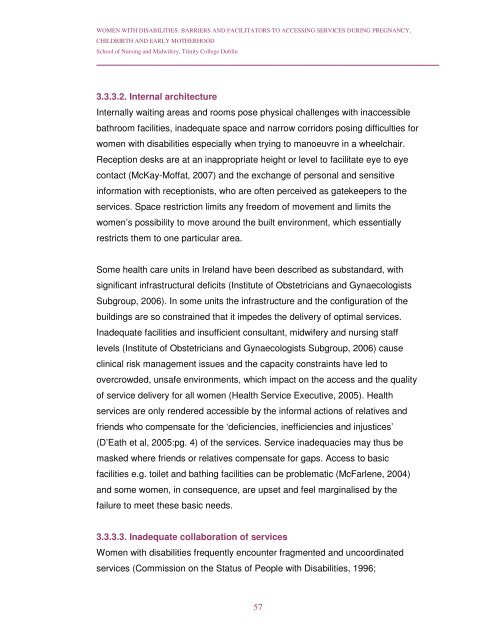Women with Disabilities: Barriers and Facilitators to Accessing ...
Women with Disabilities: Barriers and Facilitators to Accessing ...
Women with Disabilities: Barriers and Facilitators to Accessing ...
Create successful ePaper yourself
Turn your PDF publications into a flip-book with our unique Google optimized e-Paper software.
WOMEN WITH DISABILITIES: BARRIERS AND FACILITATORS TO ACCESSING SERVICES DURING PREGNANCY,CHILDBIRTH AND EARLY MOTHERHOODSchool of Nursing <strong>and</strong> Midwifery, Trinity College Dublin3.3.3.2. Internal architectureInternally waiting areas <strong>and</strong> rooms pose physical challenges <strong>with</strong> inaccessiblebathroom facilities, inadequate space <strong>and</strong> narrow corridors posing difficulties forwomen <strong>with</strong> disabilities especially when trying <strong>to</strong> manoeuvre in a wheelchair.Reception desks are at an inappropriate height or level <strong>to</strong> facilitate eye <strong>to</strong> eyecontact (McKay-Moffat, 2007) <strong>and</strong> the exchange of personal <strong>and</strong> sensitiveinformation <strong>with</strong> receptionists, who are often perceived as gatekeepers <strong>to</strong> theservices. Space restriction limits any freedom of movement <strong>and</strong> limits thewomen’s possibility <strong>to</strong> move around the built environment, which essentiallyrestricts them <strong>to</strong> one particular area.Some health care units in Irel<strong>and</strong> have been described as subst<strong>and</strong>ard, <strong>with</strong>significant infrastructural deficits (Institute of Obstetricians <strong>and</strong> GynaecologistsSubgroup, 2006). In some units the infrastructure <strong>and</strong> the configuration of thebuildings are so constrained that it impedes the delivery of optimal services.Inadequate facilities <strong>and</strong> insufficient consultant, midwifery <strong>and</strong> nursing stafflevels (Institute of Obstetricians <strong>and</strong> Gynaecologists Subgroup, 2006) causeclinical risk management issues <strong>and</strong> the capacity constraints have led <strong>to</strong>overcrowded, unsafe environments, which impact on the access <strong>and</strong> the qualityof service delivery for all women (Health Service Executive, 2005). Healthservices are only rendered accessible by the informal actions of relatives <strong>and</strong>friends who compensate for the ‘deficiencies, inefficiencies <strong>and</strong> injustices’(D’Eath et al, 2005:pg. 4) of the services. Service inadequacies may thus bemasked where friends or relatives compensate for gaps. Access <strong>to</strong> basicfacilities e.g. <strong>to</strong>ilet <strong>and</strong> bathing facilities can be problematic (McFarlene, 2004)<strong>and</strong> some women, in consequence, are upset <strong>and</strong> feel marginalised by thefailure <strong>to</strong> meet these basic needs.3.3.3.3. Inadequate collaboration of services<strong>Women</strong> <strong>with</strong> disabilities frequently encounter fragmented <strong>and</strong> uncoordinatedservices (Commission on the Status of People <strong>with</strong> <strong>Disabilities</strong>, 1996;57
















